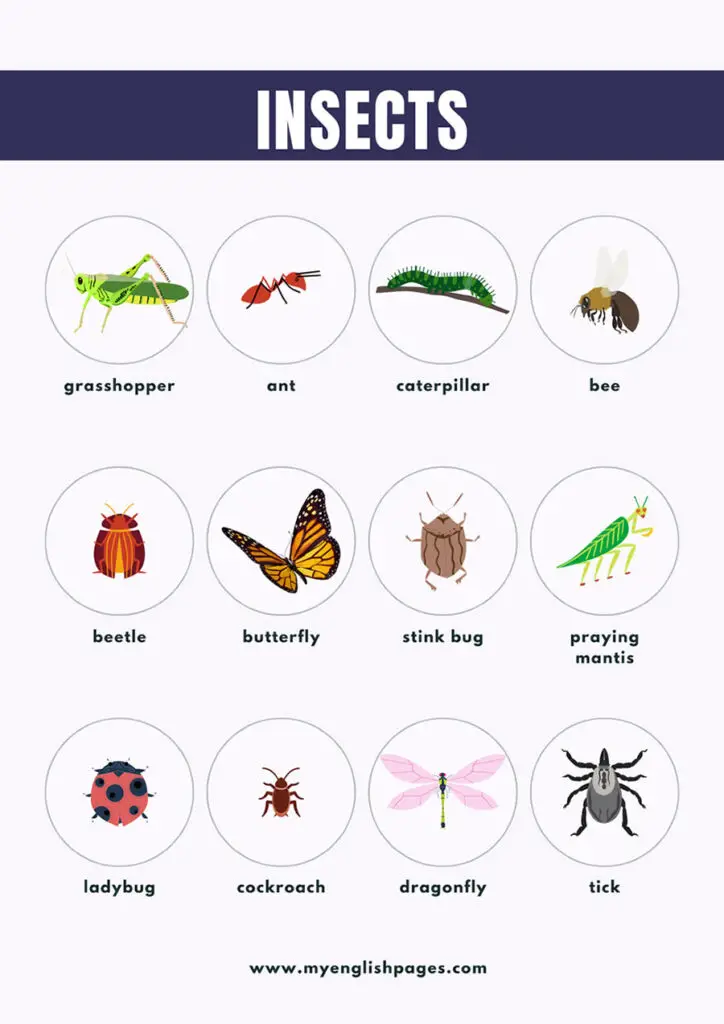Table of Contents
Introduction
Knowing bugs and insects names in English is essential for language learners in general and those who study biology in particular. Tn this guide, we will provide a list of insect and bug vocabulary with illustrations and explanations.
Let’s get started!
Vocabulary Related To Bugs And Insects
This is a list of vocabulary Items related to bugs and insects. Let’s start with an initial illustrated list:
Illustrated List of Insect and Bug Vocabulary
Flying insects

Bee
Bees are known for their role in pollination and for producing honey and beeswax.

Wasp
can be quite aggressive and can sting more than once, unlike bees

Fly
They are known for transmitting diseases.

Dragonfly
Dragonflies are valuable predators that eat mosquitoes, and other small insects like flies, bees, ants, and very rarely butterflies. They are usually found around lakes, ponds, streams and wetlands

Moth
A moth is an insect closely related to the butterfly. Moths are nocturnal.

Butterfly
A butterfly is a mainly day-flying insect whose life cycle consists of four parts: egg, larva, pupa, and adult.

Mosquito
The females of many species of mosquitoes are capable of drinking blood from many mammals. They are vectors for several infectious diseases.

Grasshopper
Grasshoppers are winged, but their wings are not fit for flight.

Cricket
Crickets are insects somewhat related to grasshoppers. They tend to be nocturnal.
Crawling Insects

Caterpillar
Caterpillars have been called “eating machines”, and eat leaves voraciously.

Cockroach
Cockroaches are associated with human habitation.

Spider
Spiders are found worldwide on every continent except for Antarctica. A few species of spiders are venomous and are dangerous to humans.
.

Louse
(plural: lice) It feeds on human blood.

Ant
It lives in nests and most varieties are harmless, although some can also bite.

Worm
Some worms occupy parasitic niches (inside human and animal bodies.) Others live on land, in marine or freshwater environments.
Detailed list of bugs and Insects in English

Flying Insects
- Monarch Butterfly (MON-ark BUT-er-fly)
- Description: The Monarch Butterfly is orange with black lines. It is famous for flying long distances.
- Habitat: Gardens and fields.
- Interesting Fact: Monarch Butterflies travel very far, sometimes up to 3,000 miles!
- Housefly (HOWS-fly)
- Description: Houseflies are small, gray insects with red eyes. They are very common.
- Habitat: Houses, farms, and garbage areas.
- Interesting Fact: Houseflies can only eat liquid food. They spit on solid food to make it liquid.
- Dragonfly (DRAG-un-fly)
- Description: Dragonflies have long bodies and two pairs of wings. They are often brightly colored.
- Habitat: Near water such as ponds and streams.
- Interesting Fact: Dragonflies can fly up to 30 miles per hour.
- Bee (BEE)
- Description: Bees are yellow and black insects that are known for making honey.
- Habitat: Gardens, forests, and fields.
- Interesting Fact: Bees play a crucial role in pollinating flowers.
Crawling Insects
- Ant (ANT)
- Description: Ants are small insects that live in large groups. They are very strong for their size.
- Habitat: Gardens, forests, and homes.
- Interesting Fact: Ants can carry objects that are many times heavier than their own body.
- Ladybug (LAY-dee-bug)
- Description: Ladybugs are small and round with red and black spots. They are good for gardens.
- Habitat: Gardens and fields.
- Interesting Fact: Ladybugs can eat up to 5,000 small insects called aphids in their life.
- Cockroach (KOK-roach)
- Description: Cockroaches are brown or black insects that are often found in houses.
- Habitat: Houses, restaurants, and other buildings.
- Interesting Fact: Cockroaches can survive for weeks without food.
- Termite (TUR-mite)
- Description: Termites are small, pale insects that eat wood.
- Habitat: Wood structures, forests, and underground.
- Interesting Fact: Termites play a key role in breaking down dead wood in forests.
Nighttime Insects
- Luna Moth (LOO-nuh MAWTH)
- Description: The Luna Moth is light green with long tails on its wings. It is very large.
- Habitat: Forests with many trees.
- Interesting Fact: Luna Moths do not eat. They only live for about one week as adults.
- Firefly (FY-er-fly)
- Description: Fireflies are small beetles that light up at night.
- Habitat: Gardens, fields, and forests.
- Interesting Fact: Fireflies use their light to communicate with each other.
- Cricket (KRIK-it)
- Description: Crickets are small, brown or black insects that make a chirping sound.
- Habitat: Fields, meadows, and sometimes inside houses.
- Interesting Fact: Only male crickets chirp to attract females.
- Moth (MOTH)
- Description: Moths are similar to butterflies but are usually active at night.
- Habitat: Gardens, forests, and near lights.
- Interesting Fact: There are more species of moths than butterflies.
Water Insects
- Water Strider (WAW-ter STRY-der)
- Description: Water Striders are insects that can walk on the surface of the water.
- Habitat: Ponds, lakes, and slow-moving streams.
- Interesting Fact: Water Striders use the surface tension of water to stay afloat.
- Mosquito (muh-SKEE-toh)
- Description: Mosquitoes are small and have long legs. They bite and can spread diseases.
- Habitat: Areas with still water like ponds and puddles.
- Interesting Fact: Only female mosquitoes bite because they need blood to lay eggs.
- Mayfly (MAY-fly)
- Description: Mayflies are small insects with short lifespans, usually found near water.
- Habitat: Streams, rivers, and lakes.
- Interesting Fact: Mayfly adults live for only a few hours to a few days.
- Whirligig Beetle (WUR-lih-gig BEE-tul)
- Description: Whirligig Beetles are small, shiny insects that swim on the surface of the water in circles.
- Habitat: Ponds, lakes, and streams.
- Interesting Fact: They have divided eyes that can see above and below the water simultaneously.
Land Insects
- Hercules Beetle (HER-kyoo-leez BEE-tul)
- Description: The Hercules Beetle is very large and has a big horn on its head.
- Habitat: Rainforests in Central and South America.
- Interesting Fact: This beetle is very strong. It can lift objects that are 850 times heavier than its body!
- Grasshopper (GRAS-hop-er)
- Description: Grasshoppers are insects that can jump very far. They are green or brown.
- Habitat: Fields and meadows.
- Interesting Fact: Grasshoppers can jump up to 20 times the length of their own body.
- Praying Mantis (PRAY-ing MAN-tis)
- Description: Praying Mantises are large insects with long front legs that look like they are praying.
- Habitat: Gardens, fields, and forests.
- Interesting Fact: Praying Mantises are expert hunters and can catch and eat other insects.
- Earwig (EER-wig)
- Description: Earwigs are small, brown insects with pincers on their tails.
- Habitat: Gardens, under rocks, and in moist areas.
- Interesting Fact: Earwigs use their pincers to defend themselves and catch prey.
Conclusion
Learning about insects is a great way to improve your English. We hope this guide helps you learn new words and enjoy the amazing world of bugs and insects. Keep exploring and learning!
Related Pages:


